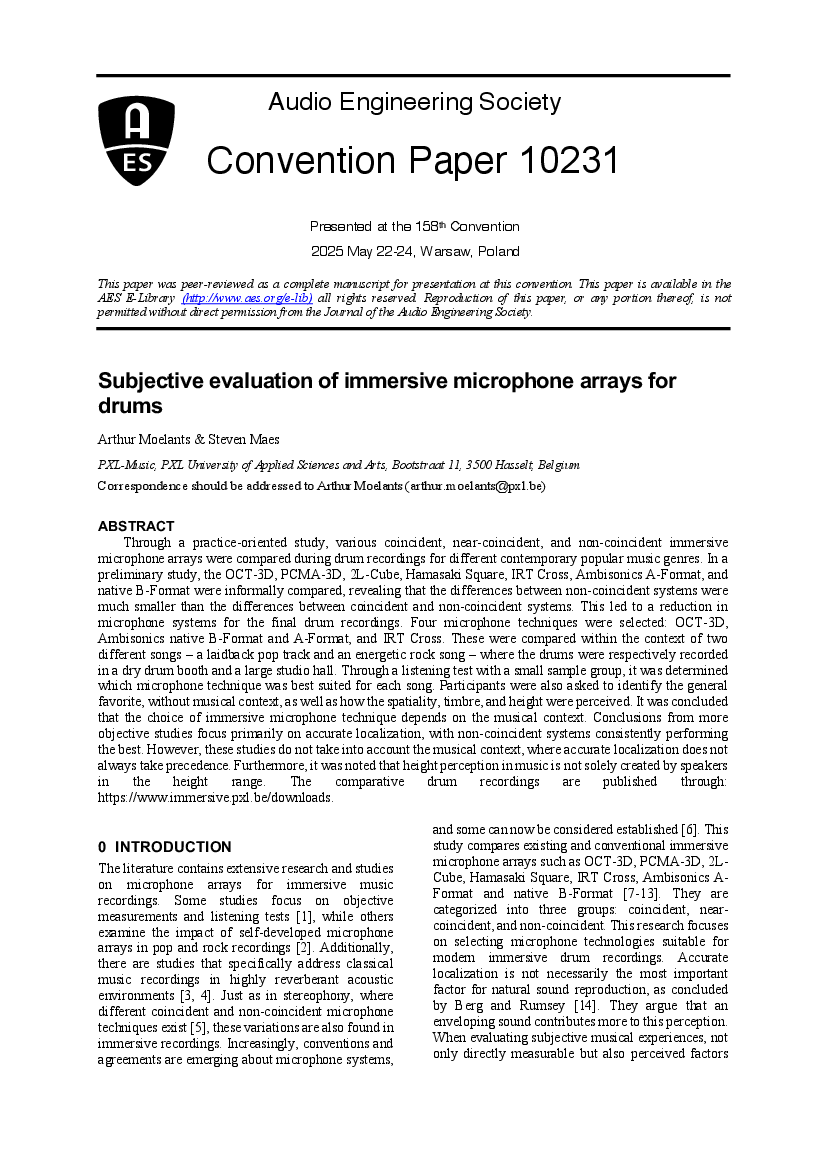Home / Publications / E-library page
You are currently logged in as an
Institutional Subscriber.
If you would like to logout,
please click on the button below.
Home / Publications / E-library page
Only AES members and Institutional Journal Subscribers can download
Through a practice-oriented study, various coincident, near-coincident, and non-coincident immersive microphone arrays were compared during drum recordings for different contemporary popular music genres. In a preliminary study, the OCT-3D, PCMA-3D, 2L-Cube, Hamasaki Square, IRT Cross, Ambisonics A-Format, and native B-Format were informally compared, revealing that the differences between non-coincident systems were much smaller than the differences between coincident and non-coincident systems. This led to a reduction in microphone systems for the final drum recordings. Four microphone techniques were selected: OCT-3D, native B-Format, Ambisonics A-Format, and IRT Cross. These were compared within the context of two different songs a calm pop track and an energetic rock song where the drums were respectively recorded in a dry drum booth and a large studio hall. Through a listening test with a small sample group, it was determined which microphone technique was best suited for each song. Participants were also asked to identify the general favorite, without musical context, as well as how the spatiality, timbre, and height were perceived. It was concluded that the choice of immersive microphone technique depends on the musical context. Conclusions from more objective studies focus primarily on accurate localization, with non-coincident systems consistently performing the best. However, these studies do not take into account the musical context, where accurate localization does not always take precedence. Furthermore, it was noted that height perception in music is not solely created by speakers in the height range. The comparative drum recordings are published through https://www.immersive.pxl.be/immersive- microphone-techniques-for-drums/.
Author (s): Moelants, Arthur; Maes, Steven
Affiliation:
PXL-Music Research department at the PXL University of Applied Sciences and Arts; PXL-Music Research department at the PXL University of Applied Sciences and Arts
(See document for exact affiliation information.)
AES Convention: 158
Paper Number:10231
Publication Date:
2025-05-12
Import into BibTeX
Permalink: https://aes2.org/publications/elibrary-page/?id=22913
(2014KB)
Click to purchase paper as a non-member or login as an AES member. If your company or school subscribes to the E-Library then switch to the institutional version. If you are not an AES member Join the AES. If you need to check your member status, login to the Member Portal.

Moelants, Arthur; Maes, Steven; 2025; Subjective evaluation of immersive microphone arrays for drums [PDF]; PXL-Music Research department at the PXL University of Applied Sciences and Arts; PXL-Music Research department at the PXL University of Applied Sciences and Arts; Paper 10231; Available from: https://aes2.org/publications/elibrary-page/?id=22913
Moelants, Arthur; Maes, Steven; Subjective evaluation of immersive microphone arrays for drums [PDF]; PXL-Music Research department at the PXL University of Applied Sciences and Arts; PXL-Music Research department at the PXL University of Applied Sciences and Arts; Paper 10231; 2025 Available: https://aes2.org/publications/elibrary-page/?id=22913